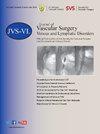在动物模型中比较VELEXTM导管空静脉消融(EVA)技术、静脉内激光消融(EVLA)和泡沫硬化治疗(FS)对静脉壁的影响。
IF 2.8
2区 医学
Q2 PERIPHERAL VASCULAR DISEASE
Journal of vascular surgery. Venous and lymphatic disorders
Pub Date : 2025-04-23
DOI:10.1016/j.jvsv.2025.102251
引用次数: 0
摘要
目的:描述绵羊体内模型经空静脉消融(EVA)技术、静脉内激光消融(EVLA)技术和泡沫硬化治疗(FS)后的残余内膜和平均中膜厚度。方法:对6条羊髂股静脉轴和2条羊颈静脉轴进行EVA治疗(使用聚多酚[POL] 0.5%或1%,接触时间1或3分钟),FS治疗(在Valsalva手法中使用FS-1和FS [FS- val], POL 1%治疗10分钟),EVLA治疗(径向1470 nm, 80焦耳/cm2)。结果:eva - pol0.5 ~ 1min平均内膜残留百分比为2% (IQR 1 ~ 4%), eva - pol0.5 ~ 3min平均内膜残留百分比为1% (IQR 0 ~ 3.5%), eva - pol1 ~ 1min平均内膜残留百分比为2% (IQR 0 ~ 4%), eva - pol1 ~ 3min平均内膜残留百分比为0,FS为13% (IQR 13 ~ 15.7%), FS- val为1% (IQR 0 ~ 3%), EVLA为1% (IQR 0 ~ 6%)。eva - pol0.5 -1min残余介质厚度平均百分比为13% (IQR 8-15%), eva - pol0.5 -3min为6% (IQR 4-9%), eva - pol1 -1min为13% (IQR 10-27%), eva - pol1 -3min为6% (IQR 5-12%), FS为51% (IQR 40-62%), FS- val为29% (IQR 23-35%), EVLA为62% (IQR 41-75%)。结论:EVA在血管内膜和中膜层均优于EVLA和FS。本文章由计算机程序翻译,如有差异,请以英文原文为准。
Comparing venous wall effects using the empty vein ablation technique with VELEX catheter, endovenous laser ablation and foam sclerotherapy in an animal model
Objective
To describe residual intima and the average media thickness persisted after the empty vein ablation (EVA) technique, endovenous laser ablation (EVLA), and foam sclerotherapy (FS) in a sheep in vivo model.
Methods
Six iliofemoral and two jugular sheep vein axes were treated as follows: four with EVA (using polidocanol [POL] 0.5% or 1% with 1 or 3 minutes as contact time), two with FS (FS-1 and FS during Valsalva maneuver [FS-Val], POL1% for 10 minutes), and two with EVLA (1470 nm radial, 80 J/cm2).
Results
The average percentage of residual intima layer was 2% (interquartile range [IQR]: 1%-4%) for EVA-POL0.5%-1 minute, 1% (IQR: 0%-3.5%) for EVA-POL0.5%-3 minutes, 2% (IQR: 0%-4%) for EVA-POL1%-1 minute, 0 for EVA-POL1%-3 minutes, 13% (IQR: 13%-15.7%) for FS, 1% (IQR: 0%-3%) for FS-Val, and 1% (IQR: 0%-6%) for EVLA. The average percentage of residual media thickness was 13% (IQR: 8%-15%) for EVA-POL0.5%-1 minute, 6% (IQR: 4%-9%) for EVA-POL0.5%-3 minutes, 13% (IQR: 10%-27%) for EVA-POL1%-1 minute, 6% (IQR: 5%-12%) for EVA-POL1%-3 minutes, 51% (IQR: 40%-62%) for FS, 29% (IQR: 23%-35%) for FS-Val, and 62% (IQR: 41%-75%) for EVLA.
Conclusions
EVA demonstrated better results in vein wall damage compared with EVLA and FS, both in intima and media layers.
Clinical Relevance
This study provides crucial insights into the effectiveness of different vein treatment techniques, particularly the empty vein ablation method, in minimizing residual intima and media thickness. By evaluating these outcomes in a sheep model, it highlights how empty vein ablation may lead to more vein wall damage compared with endovenous laser ablation and foam sclerotherapy. For clinicians, understanding the comparative efficacy of these treatments is vital for optimizing patient care in managing venous diseases. As the field evolves, these findings could influence clinical decision-making, encouraging the adoption of techniques that promote better long-term outcomes for patients.
求助全文
通过发布文献求助,成功后即可免费获取论文全文。
去求助
来源期刊

Journal of vascular surgery. Venous and lymphatic disorders
SURGERYPERIPHERAL VASCULAR DISEASE&n-PERIPHERAL VASCULAR DISEASE
CiteScore
6.30
自引率
18.80%
发文量
328
审稿时长
71 days
期刊介绍:
Journal of Vascular Surgery: Venous and Lymphatic Disorders is one of a series of specialist journals launched by the Journal of Vascular Surgery. It aims to be the premier international Journal of medical, endovascular and surgical management of venous and lymphatic disorders. It publishes high quality clinical, research, case reports, techniques, and practice manuscripts related to all aspects of venous and lymphatic disorders, including malformations and wound care, with an emphasis on the practicing clinician. The journal seeks to provide novel and timely information to vascular surgeons, interventionalists, phlebologists, wound care specialists, and allied health professionals who treat patients presenting with vascular and lymphatic disorders. As the official publication of The Society for Vascular Surgery and the American Venous Forum, the Journal will publish, after peer review, selected papers presented at the annual meeting of these organizations and affiliated vascular societies, as well as original articles from members and non-members.
 求助内容:
求助内容: 应助结果提醒方式:
应助结果提醒方式:


